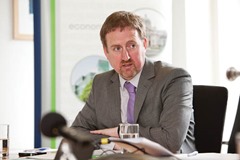Electromobility in Ireland
 ESB hosted an round table discussion on the future of electromobility in Ireland and how best to facilitate the market for electric vehicles.
ESB hosted an round table discussion on the future of electromobility in Ireland and how best to facilitate the market for electric vehicles.
How do you see the future of electromobility unfolding in Europe and in Ireland?
Dermot McArdle
ESB, as a utility, is 100 per cent convinced that electromobility is going to have a significant future in Ireland and across Europe. That is also the view of global bodies like the International Energy Agency and, nationally, SEAI. All the macro factors are pointing us in one direction, towards more sustainable transport requirement. In the next 30 to 40 years, electric vehicles (EVs) will constitute the major part of the passenger and light goods vehicle sectors.
Andrew Graham
I would agree that EVs will contribute a big part in the future. I think EVs are key to delivering carbon reductions but I think it is going to be much slower than initially anticipated, as the technology hasn’t kept pace with the ambition. Also, the vehicle manufacturers have not pinned their colours to one specific mode of transport. They haven’t given up on fossil fuels and they are making their fossil fuel cars more efficient. So I think eventually fossil fuels will go but is a lot further in the future than many anticipate.
Graham Brennan
Transport is one of the tricky areas to reduce emissions from because you need a high energy density source for mobility. The internal combustion engine has been around for a long time and is a mature technology. When you look at Europe’s ambitions in getting to a vehicle fleet that has a 95 g/kg average CO2 emissions by 2020, it is very difficult to see how they are going to do that if they do not get electric vehicles into the mix.
I think the rate of development is faster than many people believe and I think we are on track. The IEA predicts that if the price of a battery gets to €300/kW/kg, EVs will reach parity with combustion engine vehicles. IEA predicts this to happen before 2020. The US Department of Energy showed that in 2008 the price was €1,000/kW/kg and it is now €485/kW/kg. It is developing very quickly. EVs are here to stay and the environmental benefits are clear.
Conor Dixon
Electric vehicles are here for good and they will mould part of the future of the motor industry. The average daily mileage for the Irish motorist is 37.5 km, so these vehicles suit more people than we think. Renault will continue to support EVs with a full range adapted to everyone’s need. Renault Ireland will launch the Twizy later this year and the ZOE next year. We are very happy with battery life and the reliability of the power train. They have been launched for more than two years now, and have been tested in all types of working environments.
If the electric vehicle is here to stay, I think how quickly the take-up will depend on a number of factors including incentives from government and price. Environmental issues are all very well and they might help people feel a little bit better but the person on the street needs more of a choice of cars. We need more manufacturers involved. If more cars are out there it will evolve naturally, because I have driven the Fluence, the Kangoo and the Nissan Leaf and they are brilliant fun. It is a bit like using an old dial phone and then using a smart phone, it’s that much of a difference. They are fast and they are fun.
David Lee
As a service provider to the industry, we have noticed a step change in interest in EVs over the past 12 months, particularly in the Nordic countries, Germany and Switzerland. It has evolved from curiosity to tangible plans to progress projects. In addition to the impact on transportation, EVs have a key role in the electricity industry in helping us meet our emissions targets. In time, the electric vehicle will also have a key role to play in terms of energy storage. The pace of technology evolution continues to accelerate. IBM is involved in a project called ‘Battery 500’ which aims to increase battery range to 500 miles in a single charge which addresses consumer concerns over range anxiety. So I am absolutely positive that EVs are here to stay and the only question is the pace of evolution.
Denise Keoghan
While it is the Department of Communications, Energy and Natural Resources that has lead responsibility for electric vehicles, the Department of Transport, Tourism and Sport, which leads on sustainable transport policy, fully supports the policies being pursued to promote EV use in Ireland. The target of having 10 per cent of transport fuels from renewable resources by 2020 will require significant uptake in biofuels and EVs. From a Department point of view, we will be looking to create the right environment to encourage usage of alternative fuels in the transport sector. While disappointed by the lack of electric vehicle penetration in the car market to date, we feel this is understandable given issues such as price competitiveness and re-sale value of second-hand EVs. Nevertheless, we feel that Ireland is on the cusp of market change at this point with electric cars now comparing favourably in purchase cost terms. EV travel range is getting longer and there is now a growing confidence that these cars can compete on an equal footing with other vehicles in the market.
What are the key factors necessary for mass market adoption?
Clearly, government and European policy are key drivers for the sector. This includes the Renewable Energy Directive, air quality and emissions directives and manufacturers’ obligations on emissions. In relation to motorists, any of the market research shows that the running costs of an EV are significantly lower than those of a traditional petrol or diesel car. Other issues that need to be addressed include choice and availability of ecars.
There are currently only a few new EV models on the market but most manufacturers, if not all of them, plan to address that over the next year or two. As the choice gets wider, customers will see EVs as a more mainstream choice. Price is also a factor. Two years ago, they were seen as significantly more expensive than traditional fossil fuel cars but they are now comparable in terms of price.
Range is also a perceived issue, as the range of an EV is lower than a conventional car. That is why you need mitigating factors such as public re-charging infrastructure, which has been rolled out by ESB. As the issues of price, choice and range are overcome – and they are being addressed – it makes EVs a very viable choice for consumers.
Garry Martin
On a more micro level, if government policy could help improve the driving experience with EVs such as freeing up bus lanes for EVs as they do in Norway. I recently saw a picture of an EV being charged on Adelaide Road with a clamp on it. What kind of message does that send out? There are things like free parking and using bus lanes that would help incentivise the uptake of EVs with a little bit of innovation to make people’s travel easier in an urban environment.
Conor Dixon
When you get into an electric vehicle now, you have to plan your trip. It is not great when you cross the city and you can’t get access to a charging point because another fossil fuel vehicle is parked in the space. Restricted parking for EVs would address that. A wide availability of charging facilities and simple charging methods are a must.
Graham Brennan
A lot of surveys have been done across Europe and when they interviewed people before they bought an EV, range anxiety was top of the list. After they had the car for a while, they surveyed them again and found that range anxiety went down the list. What went up to the top was the price of the car. I think that is because people are very adaptive. The new cars coming out now have a range of 200km and if most of your journeys are around the city, they will not be charging it as much as you think.
David Lee
Research we commissioned in North America showed that affordability is the single biggest factor, with 71 per cent of respondents saying price was the key factor. Addressing this goes hand-in-hand with education and awareness. A lot of the focus is on the upfront capital cost and an under-appreciation of the lower operating costs. Another area is protecting the re-sale value. There is a role for more innovative financing to protect people from technological obsolescence over the lifetime of their investment.
Graham Brennan
I think there is actually the prospect of the second hand value of these cars being very strong. Most of the people buying EVs have two cars, with the EV being used to reduce cost of driving around the city. In three or four years’ time, the EV will still offer lower urban driving costs and its re-sale value could be very strong. Also in the future, if the price of batteries comes down substantially, you may well find people, rather than buying a new car, buying a battery pack and a software change to give them a car that goes faster and further.
As price seems to be the main barrier, what incentives are necessary to accelerate the market?
Conor Dixon
I think reducing the BIK would be a good incentive, particularly for company cars. Other incentives such as free tolls and car sharing schemes would also help develop the market.
Denise Keoghan
The Department of Transport is currently preparing regulations that will allow local authorities to designate parking spaces for the recharging of electric vehicles and car clubs. Local authorities are beginning to consider alternative uses for parking spaces and it is likely, with the expansion of the market, that you will see more space becoming available for use by electric vehicles.
Price is key and, for whatever reason, the perception is that EVs are expensive. The grant from SEAI is very helpful in addressing that. The range anxiety, whilst not rational, is a real concern. Getting to a range of 500km would kill that off. There also needs to be a bigger network of fast chargers around the country. Forecourts have a role to play in that and also ESB has been working hard to roll out a network. The forecourt of the future will have more recharging units and we are putting them in every new forecourt.
Garry Martin
Price is currently the number one issue. People just see the capital cost and don’t see the ongoing savings. In addition to the grant, there are some innovative financing products coming to the market which are effectively ‘buy as you save’ products. My own personal view is that EVs will initially be adopted in households with two or more cars. There are upwards of half a million households in urban areas in this category.
Graham Brennan
The primary incentive is in two parts to bring the capital cost of the car down. One is a grant from SEAI of €5,000. The other is a VRT reduction of up to €5,000. That gives you €10,000 and when you add in the fuel cost savings, that should make the vehicle attractive in terms of ownership lifecycle costs, but you are looking at a three-to-four year period before those savings show themselves. When we started the scheme in 2011, the first vehicles had an unsubsidised price of €40,000. Now two-and-a-half years later vehicles are coming in at €31,000 (unsubsidised price), because of factors like Nissan building a factory in Europe. The new cars are cheaper and have higher ranges of 200km.
How is the roll-out of EV technology going and the development of inter-operability across Europe going?
Dermot McArdle
With the advent of EVs there will be more integration between the electricty and transport sectors. It will be IT services that will help the integration of the two – and not just within national borders. Someone with an EV going on holidays to France will want to take it with them, the same as their mobile phone, and expect to be able to charge it.
A key to the development of inter-operability is the development of standards. If you look at mature technology markets, you need to have a stable base on which to build. I think the on-going efforts at a European level to come up with inter-operability standards will enable the ease of movement for consumers and also provide safety and development standards for suppliers.
In terms of technology, the development of a set of European-wide standards that enable inter-operability across borders is equally as important as the continued development of battery technology.
Denise Keoghan
The proposed EU Alternative Fuels Directive is gaining momentum in Europe and is aiming to address the whole area of inter-operability by introducing common technical standards for infrastructure. A key aim of the proposed Directive is to achieve greater market penetration of alternative fuels and the proposed Directive is seeking to introduce targets for EV charging points across Europe.
Besides the environmental and cost advantages already mentioned, what are the other advantages of adopting electric vehicles?
David Lee
In addition to providing energy for transportation, EVs also provide a mechanism for storing energy. In Ireland we have a target of 40 per cent of electricity by 2020 from renewables. A lot of that energy will be generated at night, so where do you store it for use during the day? You could use the EV batteries as dispersed storage units. That interlock between the two industries will be crucial, particularly in an Irish context given our plans for renewables.
Dermot McArdle
At a very simple level, the Government target is 250,000 EVs by 2020. That level of penetration on the system from a utility point of view would help flatten the load curve and bring up the demand at night when people re-charge their vehicles. Our analysis shows that this would save between €40 million and €50 million per year in energy costs. It will also help address the issue of wind curtailment.
We are also an island system off the west of Europe, with increasing but still limited inter-connection with the UK and the rest of Europe. Vehicle to grid technology will certainly help manage the system and reduce cost.
Conor Dixon
From a fleet management point of view, there are advantages of reduced maintenance costs and longer service intervals. You can also manage costs with smart charging, charging at night. Low CO2 emissions reduce road tax bills and any company conscious of its carbon footprint will be keen on EVs. In general, the maintenance is not just a lot cheaper but the environmental cost of the service is much lower. For example, a standard diesel engine will produce waste engine oil over the lifetime of the vehicle, whereas EVs do not. Replacement of brake pads and discs is also significantly lower.
 What one area should the industry and policy makers focus on to make EVs happen?
What one area should the industry and policy makers focus on to make EVs happen?
Denise Keoghan
At the moment, it is technology and price competiveness in the market that will lead the way. More car manufacturers are entering into the EV market and I think that greater competition will lead to further innovation in EV related technologies. Without question, the Government grant helps EVs to compare favourably in purchase price terms and its continuation should certainly help with the future take-up of EVs. From the Department’s perspective, we want to ensure that we put in place the right supports, in terms of regulation and standards, to remove any barriers to the expansion of the EV market.
David Lee
Not to under estimate the need to educate the consumer in relation to the business case for EVs. It is a consumer market and you have to understand your buyer.
Garry Martin
Until the market settles down and there is a level playing field, and people understand the benefits of EVs, it is important that government grants are still available. If these grants were taken away, the rise in prices would kill the EV market in Ireland. To maintain these levels of grants in the near and medium future is critical until there is more choice and the economies of scale that will bring prices down.
Conor Dixon
I agree, until the market settles down, and the technology settles down as well, any small change can affect the residual value of an EV. Until customers see a steady trend across the market there needs to be a good level of support.
At the moment there are 180,000 EVs around the world and that sales figure has doubled from 2011 to 2012. The actual price of the equipment will not be affected by how many vehicles are sold in the Irish market. So while we are waiting for the global market to bring down costs, the best thing we can do is to begin a demonstration programme, similar to ESB’s Ambassador programme, to allow people easy access to EVs and to let them try them for a period of rime. This would allow them to get a feel for EVs so that they become a purchaser of an EV when the price is right.
Andrew Graham
I would support what the other participants have said but I think in the EV space the game-changer will be battery technology improvements. Once the range anxiety – rational or not, it is there in the consumer’s mind. Once that is addressed, I think EVs will take-off.
Dermot McArdle
One thing that struck me as we went around the table is that so many people from different sectors are involved in EVs. The one thing I think we are good at in Ireland is to bring together all the main players in a co-ordinated fashion. EVs are going to happen and that can come about in a manner where we can achieve the optimum benefits for the country or it can happen in an altogether different way.
Government policy is critical, as is European policy. To date, the Irish Government has been very positive and strong in that area. The single most important thing is that we continue to manage the introduction of EVs in a co-ordinated fashion involving all the main stakeholders.
The participants
Graham Brennan
Graham Brennan is the Sustainable Transport and Ocean Energy Programme Manager with responsibility for the Electric Vehicle Programme in the Strategic Energy Authority of Ireland. A graduate of mechanical engineering from University College Galway and Cranfield University, he previously worked in offshore oil and gas in Aberdeen and Rolls-Royce Aero Engines in Derby.
Conor Dixon is Fleet Service Manager with Renault Ireland. He has been involved in the motor trade for the last 25 years, starting his career as a motor mechanic and became one of the first Volvo master technicians in Ireland. He then held a number of management positions with Renault. Conor has been involved in the Renault’s EV programme since it was launched in 2010.
Andrew Graham
Andrew Graham is Head of Business Development and Strategy with Topaz Energy. He currently has primary responsibility for the acquisition of new businesses and the pursuit of innovative income opportunities. An accountant with over 12 years’ experience in Ireland, he has held various management roles in Topaz Energy and Statoil Ireland. He is originally from New Zealand.
Denise Keoghan
Denise Keoghan works in the Sustainable Transport Division of the Department of Transport, Tourism and Sport where she has responsibility for issues relating to the National Cycle Programme and climate change. Denise joined the Civil Service in 2000 and has spent most of the interim in various areas across the department, including road safety, finance and roads policy.
David Lee
David Lee is an Executive Partner in IBM Global Business Services where he is responsible for the delivery of consulting and systems integration services in the Irish energy and utilities and telecommunications industries. He has over 20 years’ consulting experience. His area of specialism is IT strategy and planning and he also represents IBM on Smart Grid Ireland.
Garry Martin
Garry Martin has been chief executive of M2C, a DCU engineering start-up specialising in electric vehicle charging infrastructure, since 2009. M2C won an EU tender in 2012 to supply the ESB with domestic electric vehicle chargers. Garry has 20 years’ experience in SME start-ups at directorship level, and is a graduate of UCD and the London College of Communications.
Dermot McCardle
Dermot McArdle is Head of ESB ecars, a division of ESB, which is rolling-out electric vehicle infrastructure in Ireland and supporting IT/communications systems. With a background in IT and finance, Dermot has over 27 years in the energy industry, previously working in senior management roles in generation, supply, IT and finance.











